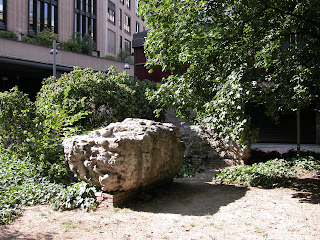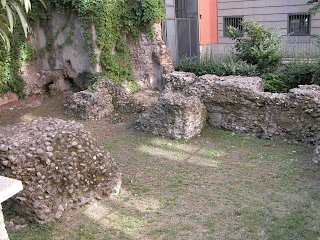
The traditional date of the foundation of Rome was the 21st of April in 753 B.C., 2766 years ago....Happy Birthday, Rome, still one of the most fascinating cities in the world. (photo: March 18, 2013)
Can't make it to Rome? Milan has its very own ancient Roman history...More......
...it was the de facto capital of the western Roman empire from the late 3rd century until the early 5th, after all. Snippets of ancient Roman Milan are still scattered around town and in our museums. Hmmm, let's see how many I can remember off the top of my head.
First off, the very structure of the city of Milan is a mishmash of the earlier higgledy-piggledy city, begun around 388-386 B.C. by migrating Celts, the natural and man-made waterways and the square Roman plan (from the 1st century B.C./A.D.). Over a century had passed quietly from the founding of the Celtic city, then these Gallic Milanese made either one of their biggest mistakes, or their best decisions: they sided with other Gauls and Hannibal in the fight against the growing power of Rome. Everything began to hit the fan in 225 B.C., and was resolved only by Rome's final victory over the Gauls in 194 B.C. (not to mention Hannibal's being recalled to Carthage).
It took about 100 years before the Romans would trust the Milanese enough to grant it the status of a colony in 89 B.C. (Lex Pompeia) in recognition of the city's fealty (to the winning faction...) during the civil wars. From 58 to 52 B.C., the Milanese played their cards right, again, and offered Julius Caesar a safe haven at his back during the Gallic Wars, for which the Transpadana area was awarded municipium status in 52 B.C. by Julius, and the city of Milan in particular was rewarded with full status as a Roman city in 49 A.C. (Lex Roscia). In 42 B.C., the city was aggregated with the Transpadana area in Augustus' reform of the provinces, and was named capital city of the XI region in 15 B.C.

Things trundled along quite happily; the local Celts intermarried with the Romans, and developed their own version of a Roman identity. A great and readily available example under the portico of Corso Vittorio Emanuale at number 13 or 14 is "Sciór Carera," that is, "Mister Carera," the last name being a mangled version of the first word (carere, that is, to be without) in the Latin inscription accompanying this ancient Roman sculpture under which from time immemorial satirical comments were posted to the powers-that-be.
When Gauls began to press the western part of the empire, again, the de facto capital was moved to Milan in 286 A.D. by Massimiano. During this heyday period, Ambrose, elected bishop of Milan in 374 A.D. (the title of archbishop did not exist until about four centuries later), supported Orthodox against Arian Christianity, decisively influencing the entire history of the Judeo-Christian world until his death in 397 A.D.

The milleniums of Christian history are expressed in the churches he established in Milan, three principal ones of which are still standing (San Simpliciano [photo, August 14, 2004], San Nazaro and Sant'Ambrogio still have ancient bits, though less immediately visible in the latter). The capital of the western empire remained in Milan until 402 A.D., when--again under the pressure of Gallic invasions--Honorius moved the capital to the gorgeous city of Ravenna on the Adriatic (from whence it was easier to run away...), and Milan began a long period of ups and downs not definitively resolved until the late medieval period.
Like a wheel, Milan spins outward from the area now defined by Piazza Cordusio (perhaps the ancient Celtic center, and favored by the early medieval Lombards), Piazza del Duomo (perhaps the site of a Celtic temple that became the site for Christian churches today represented by the Duomo founded in the Late Gothic period) and Piazza San Sepolcro (the ancient Roman center over which was constructed a church that eventually was dedicated to the Crusades, San Sepolcro/Holy Sepulchre).
The first circle of ancient Roman walls, perhaps erected in the 1st century B.C. by Julius Caesar, or in the 1st century A.D. by his adopted son, Caesar Augustus, stretched from the Carrobbio to Piazza della Scala, a brisk 20-minute walk one from the other (following the course of the northeast-southwest ancient Roman cardo massimo: via Margherita, via Manzoni, via Cantù and via Nerino roughly extended by the modern via Torino).

A large public baths complex was erected (end of the 2nd century A.D.-beginning of the 3rd century A.D.). Recovered fragments can be glimpsed in the open area behind the little church of San Vito in Pasquirolo that gives onto corso Europa. (photo, August 20, 2004)
At the end of the 3rd century A.D., Massimiliano stuck a big bubble onto the north-eastern part of town by erecting a semi-circular addition to the wall whose original stretch ran partly along where via Montenapoleone now trots, adding about 10 minutes to the walk from the lost gate in the area of Piazza della Croce Rossa to the "Carrobbio" where five streets came together under the protection of one of the ancient Roman gates.

Part of the tower is still visible there, though a bit hidden, in the parking lot in front of the Hotel Ariston. The Pane-Vino cafè is built right up against it, so if you go inside to have a snack, you can get up-close and personal. (Type "Carrobbio, Milan, Province of Milan" into Google Maps, find the Hotel Ariston--it's marked--and zoom down and around...the brick tower is visible.) (Ph0to snapped August 4, 2004)

Nearby in the aptly named via Circo begin the remains of the circus once tucked up against the enormous imperial compound stretching up to today's Corso Magenta. (Photo snapped August 27, 2004)

Part of the palace remains are easily visible in via Brisa (photo snapped August 27, 2004), other bits were incorporated into an early medieval monastery, later gifted with a still-fascinating church, San Maurizio, choc-a-bloc full of Renaissance frescoes.
Closer to our own day, its cloister was adopted as a focal point for the small, but wonderful and active archaeological museum of Milan, a visit to which is well worth the time spent. Don't forget to go down into the basement display area; the collections include ancient objects not excavated in Milan, but there also is a large portion of a lovely ancient floor mosaic excavated in town and an exposed area of remains of the Republican era walls.

Go, too, into the back courtyard, where you can enjoy the square tower, part of the carceres of the ancient Roman circus (it's known as the Tower of Ansperto after the early medieval Milanese bishop, who restored it; photo October 6, 2008),...

...and the polygonal wall tower, whose facets are so many and so small that it seems round (medieval frescoes inside are sometimes visible). Perusal of the ancient Roman tombstones in the courtyard slice right through the centuries: love, pride, grief.
The other (northwest-southeast) axis of the city, the decumano massimo, roughly followed Santa Maria alla Porta, Santa Maria Fulcorina, via del Bollo and ended aptly on the south-eastern part of town in Corso di Porta Romana at Piazza Missori, just outside of which once stretched a covered portico down the corso (that ran in front of Ambrogio's San Nazaro), a modern version of a mall. On the northern side of the city was the ancient granary, traces of which are under an office building, and visible--unfortunately--only for extraordinary reasons upon special request to the state office of public patrimony,or during sporadic "open days." (I still need to see this!)
The ancient Roman theater, roughly under today's Piazza Affari and the Milanese stock exchange (Borsa), has a highly visible map on the side of that building, which is occasionally open to visitors. The intelligent refurbishment allowed for thick glass floors so the foundations can be seen and enjoyed.
The ancient arena, once full of fierce beasts and battle-trained gladiators, neither of which inculcated great tranquility, was pointedly outside the city walls near the gigantic imperial palace compound, that took up about a third of the city's territory. The museum "Alda Levi" dedicated to it is small, but I found the exhibits a fascinating glimpse of gladiators and their lives, including the existence of ancient medals commemorating them and their achievements, thus invalidating the claim that this kind of medal was invented in the Renaissance. This is a very little known fact...so, see how smart you can sound, now?! I confess, the ruins of the arena, itself, are better than nothing, but are a bit disappointing. On the other hand, the museum is in part of what once was a Renaissance monastery (with a lovely little courtyard) run--if memory serves--by one of Francesco Sforza's and Bianca Maria Visconti's daughters, another fascinating shiver to add to the visit.

In the early 4th century, Constantine issued together with Licinius...before defeating him, and becoming the sole emperor...the famous Edict of Milan in 313 A.D., which recognized Christianity as one of the religions tolerated by the state. San Lorenzo, not far from the arena and enriched over the years with other constructions, was built more than a half a century later, but as part of the enormous imperial palace complex that he had walked (the church seen here from the back in a snap from March 12, 2005). (The 1st-2nd century A.D. ancient Roman columns now in front of the church were perhaps part of an imperial basilica or another temple, and were installed in front of San Lorenzo in a time lost in the mists of history, maybe even when the church originally was built.) During the Period of Consensus, the piazza in front of San Lorenzo was 'liberated' from medieval structures, and a copy of an ancient Roman sculpture was erected, there.
Other bits and pieces of Milan's ancient Roman past are visible around the city and in the city's museums and during special visits to underground areas. Who knows, too, what's going to happen to everything discovered during the relatively recent excavations near Sant'Ambrogio and in Piazza Meda.
Watch this space!
Enjoy!
1 comment:
I love Roman history. Fun post.
Post a Comment